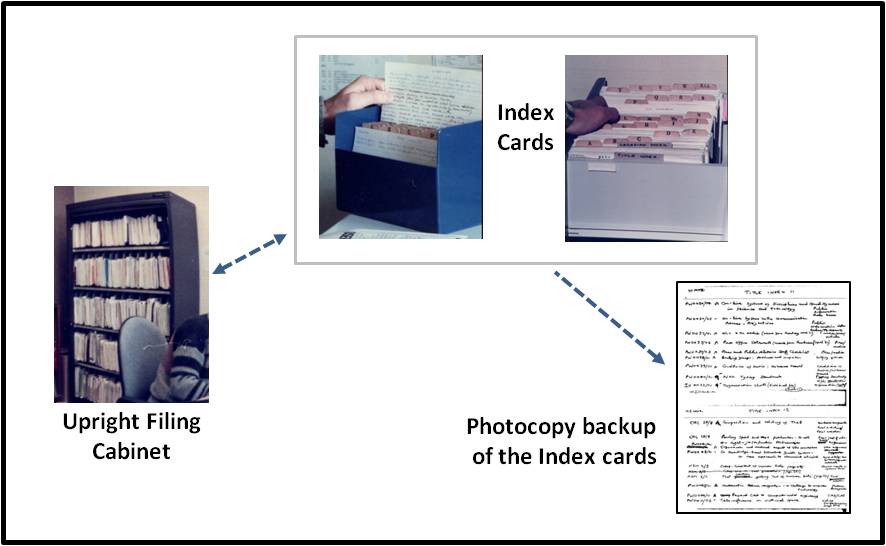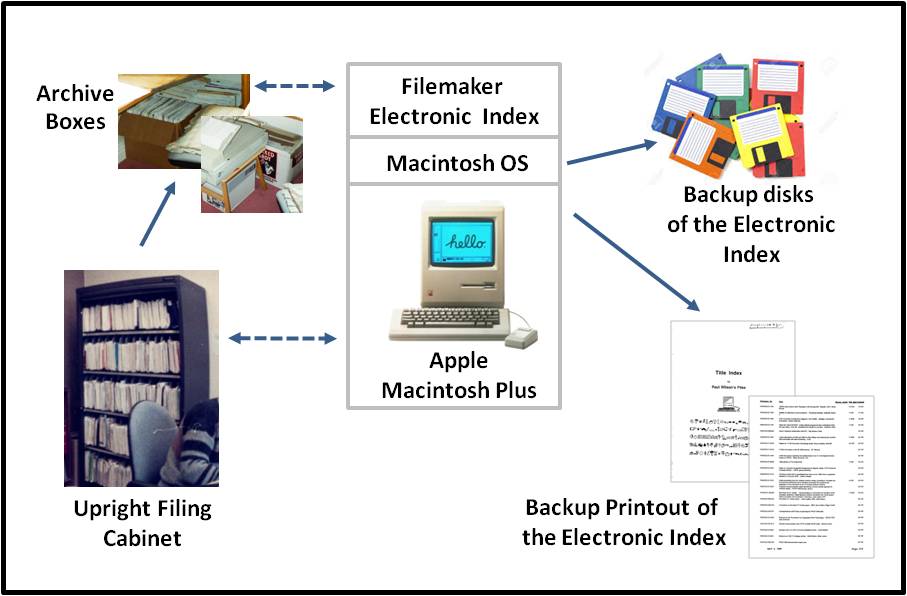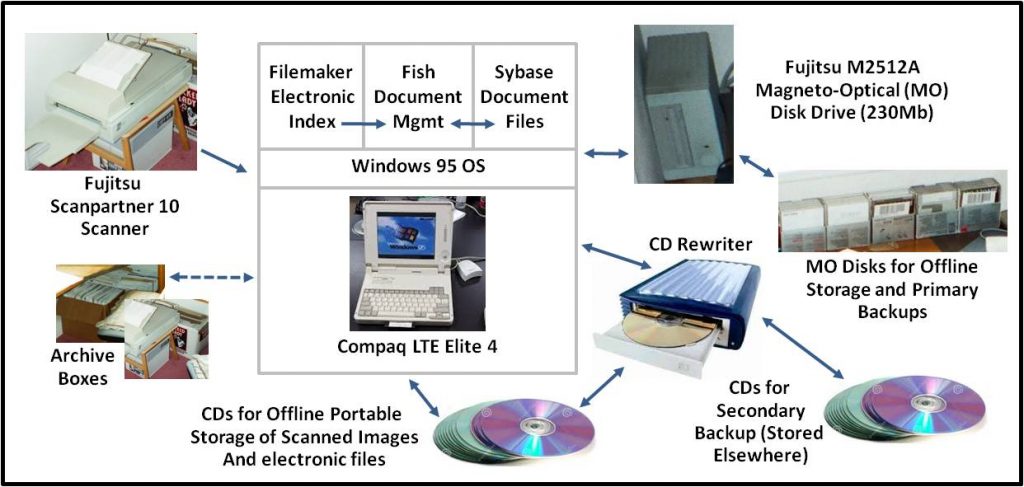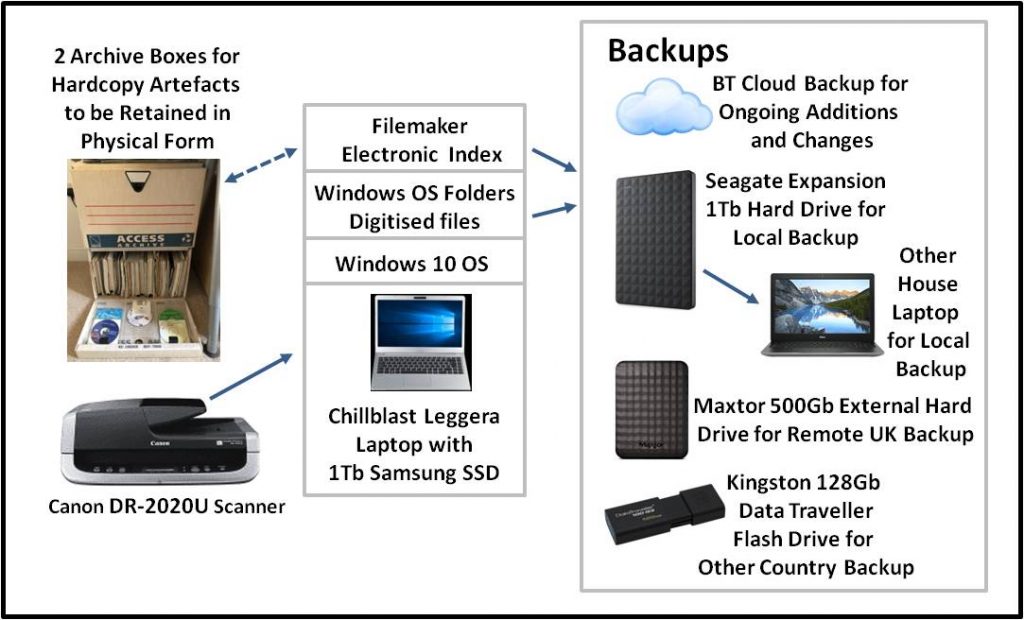Four types of prototype solutions have been used in the course of this work: card index, electronic index, electronic index and document management system, and electronic Index and file storage in Windows 10 folders. The timeline of development is shown below and the architecture of each solution is described in the subsequent text.
1980 Visit to Amoco Research Centre, Tulsa: first electronic office filing system seen
1981 First entry placed in card index (1 June 1981)
1987 Implementation of a computer-based index – Filemaker software on a Macintosh
1993 Movement of Filemaker index from Macintosh to a Compaq LTE Elite laptop running MS Windows
1994 Scanner and Magneto-Optical drive loaned by Fujitsu
1995 Paperclip Document Management software loaned by DDS
2000 Paperclip upgraded to FISH product and loaned by Ringwood Software (which was subsequently taken over by Azur Group, which was taken over by Maxima which was taken over by m-Hance)
2018 FISH document management system removed and replaced with Windows 10 folders
1. Architecture of the card index system, 01Jun1981 – 30Dec1987
This consisted of paper documents stored in an upright cabinet in serial number order, and an index on 6×4 inch cards. The cards were initially held in a small plastic box with a lid, and later on in a metal drawer. The index consisted of a series of title cards with an entry for each document (serial number, title, keywords) and a set of keyword cards – each one having a keyword on the top and then all the entries possessing that keyword listed underneath. The rationale for this filing schema was worked out with my colleague John Pritchard, and it continues to form the basis for the system as it stands today. The Card Index Architecture is illustrated below.
 2. Architecture of the electronic index, Jan1988 – Dec1994
2. Architecture of the electronic index, Jan1988 – Dec1994
After being provided with a Macintosh computer at work, I selected Filemaker, a general-purpose database with great flexibility and ease-of-use, to hold the Index. The fields used for the Filemaker index are:
- Reference number.
- Title/keywords.
- Movement status (to record the location of items borrowed by people, archived, lost, etc.).
- Publication date (to indicate when an individual item was first published).
- Creation date (to record when an item was catalogued into the filing system).
- Date last accessed (to record when an item has last been retrieved thereby enabling items that have never been accessed, or least recently accessed, to be identified as most suitable for archiving).
By 1988, the amount of paper had overflowed the upright filing cabinet and I had started to archive less frequently accessed documents to cardboard liquor boxes, which were stored around me in my office. The architecture of the Electronic Index system is illustrated below.
 3. Architecture of the electronic index and document management system, Jan1995 – Feb2018
3. Architecture of the electronic index and document management system, Jan1995 – Feb2018
In 1994, Fujitsu offered to support the work by providing, on long-term loan, a scanner and a magneto-optical storage system; and, in 1995, DDS, the European distributors of the PaperClip document management system, provided PaperClip on a long-term loan basis. By the beginning of 1996, these components had all been trialled and tested and were operational. Paperclip provides drawers, folders within drawers, and documents within folders. All the PAWDOC folders were contained in a single drawer; and a single folder was allocated to each PAWDOC Reference Number. Multiple documents of one or many formats could be contained within a folder.
Paperclip interworked with Filemaker by control key combinations which, when selected within Filemaker, copied specified information on the screen, imported it into Paperclip and enacted a Paperclip action. Two interworking functions were set up:
- Search (search for a folder in Paperclip based on a reference number picked up in Filemaker);
- Create (create a new folder in Paperclip and insert the Filemaker reference number into the folder index field).
PaperClip was upgraded to FISH in 2000. The architecture of the combined Index and document management system is illustrated below.
 4. Architecture of the electronic index and Windows 10 folders, Mar2018 – present
4. Architecture of the electronic index and Windows 10 folders, Mar2018 – present
The companies that owned the European rights to the Fish document management system were successively taken over in the first 15 years of the new millennia, and, by 2017, Fish was owned and supported by m-Hance. However, the digital preservation exercise undertaken on the PAWDOC collection in 2017 learned that there were no plans to develop Fish any further, so it was decided to remove Fish and replace it with Windows 10 folders. The conversion was undertaken successfully in 2018. The Electronic Index and Windows 10 Folders architecture is illustrated below.

